Galapagos - July 2007
by
Henry Detwiler
Suzanne and I spent four
awesome days on Santa Cruz Island in the Galapagos--not nearly enough time!
33 species--bird list is at the bottom of the page
Click on
thumbnail pictures for full-sized photos.

Page 2
 Lemon Rays Lemon Rays
|
On our second morning there, we got up to a fine mist and an overcast sky. But as the bus crested the top of Santa Cruz, we could see sunny skies ahead. We stopped offshore from Isla Baltros, and spent an hour snorkeling with the colorful fish, Black-tipped Reef Sharks, stingrays, and sea turtles.
|
| As we approached the Plaza Islands, we saw the first Red-billed Tropicbirds gliding gracefully overhead, their oversized streamers trailing behind them. |
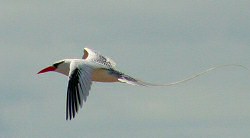
Red-tailed Tropicbird
|

Southern Sea Lions
|
As we approached the landing pier of South Plaza Island, Mario had to scare away the Southern Sea Lions by clapping with his hands, just so we'd have a path to climb up onto the island.
|
As we hiked along the trail of this tilted "table-top" island, we saw lots of Land Iguanas and Sea Lions seeking shade under the Giant Prickly Pears--sometimes sharing the same cactus. The west side of this small is at sea level, while the east side is a cliff face rising several hundred feet above the sea. |
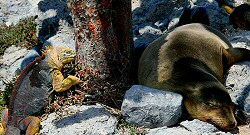 Land Iguana and Southern Sea Lion Land Iguana and Southern Sea Lion
|
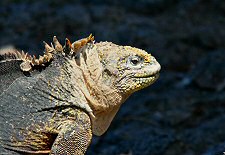
Land Iguana
The subspecies of Land Iguana here wasn't the largest variety, but were nonetheless impressive. Fortunately they are almost always vegetarians. |
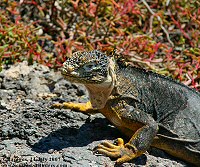
Land Iguana
|
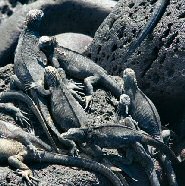
Marine Iguanas
|
Marine Iguanas covered some areas of the western coastline. They would climb atop one another to generate more heat. |
|
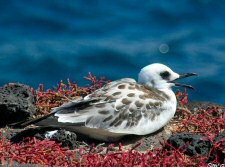
Immature Swallow-tailed Gull
|
As we got higher and closer to the east side of the island, our sightings of tropicbirds and Swallow-tailed Gulls increased. Both these birds and shearwaters used the cliff faces to nest and raise their families. The immature Swallow-tailed Gull looks nothing like the adult--I thought it was a different species when I first saw it.
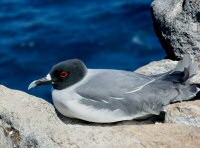
Swallow-tailed Gull
|
|
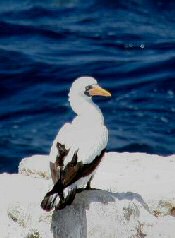
Nazca Booby |
A pair of Nazca Boobies perched at one end of the island. These gleaming white boobies preferred higher perches, as compared to the Blue-footed Boobies, which nested much lower on the islands. Both of them are excellent fishermen, diving for fish from extraordinary heights. |
At a saline lagoon next to a Santa Cruzan beach, we saw a pair of Greater Flamingoes methodically feeding. This subspecies numbers between 400-500 birds in the Galapagos, building high mud nest in the lagoons.
|
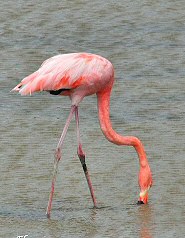
Greater Flamingo
|
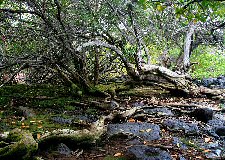
|
The southern shore of Santa Cruz Island is ringed by mangrove groves. These groves provide breeding habitat for Yellow Warblers, finches, and lots of crabs. Some of the trees have very impressive, raised root systems. |
The subspecies of Yellow Warbler that lives in the Galapagos looks similar to the ones that live stateside, but the immatures/juveniles look even more different. I thought I'd found a new species of bird when I saw this young Yellow Warbler.
|

Yellow Warbler (immature)
|
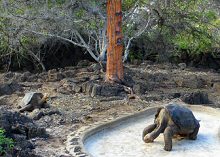
Galapagos Turtle - Lonesome George
|
On our last morning in the Galapagos we visited the Darwin Research Station, where we learned about the recovery efforts to re-establish tortoise subspecies in danger of extinction. An example being Lonesome George, the last of his line from one of the outlying Galapagos Islands. The tortoises were almost wiped out when early sailors took them for food--each large turtle could sustain a crew for weeks. |
GALAPAGOS - Page 1 |